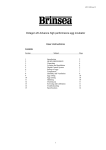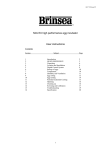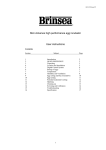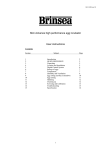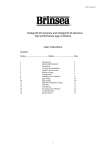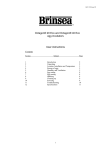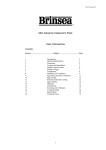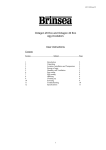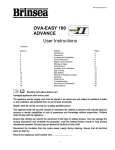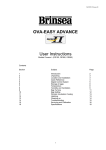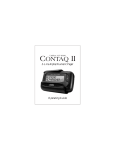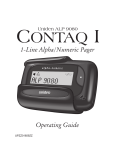Download Operating Instructions
Transcript
Q3000 GB Issue 03 Operating Instructions 1 Q3000 GB Issue 03 2 Q3000 GB Issue 03 Contents Section Subject Page 1 2 3 4 5 6 7 8 9 10 11 12 13 14 Introduction Unpacking Storage of Eggs Modes of Operation Setting Up Your Contaq Z6 Temperature Control Humidity Control Turning Cooling Hatching Servicing and Cleaning Troubleshooting Technical Fault Finding Specification 3 5 5 6 6 15 16 18 20 20 21 22 23 28 1 Introduction Congratulations on your purchase of the most advanced egg incubator available. The Contaq Z6 has been designed to allow the best possible environment for your eggs to incubate and hatch. These instructions detail the operation of your new Contaq incubator, incorporating Contact Incubation Technology (CIT). Please read them carefully before setting up the incubator in order to achieve best results. A background into CIT The method of contact incubation technology is actually as old as the birds themselves – but what is new is the unique way the method is applied to this Contaq machine. The Theory Behind the Product Contact incubation is based on the natural incubation process. The most striking difference between natural and artificial incubation is the fact that the natural parent provides warmth by contact rather than surrounding the egg with warm air. This may not at first sight seem significant but important research studies carried out by J. Scott Turner at New York State University and the University of Cape Town has revealed major unsuspected differences in thermal behaviour of eggs incubated by contact rather than convection. Crucially, eggs in a forced draft incubator have near uniform temperature throughout incubation; there will be some increase in embryonic temperature towards the end of incubation as a result of increased metabolism but otherwise the whole egg will remain near incubator air temperature. By contrast, eggs incubated naturally or by contact, have significant temperature differences. Heat is entering the egg over a relatively small brood patch, which is therefore warmer than other regions of the egg, and is being lost from most of the remaining shell area which is cooler. 3 Q3000 GB Issue 03 In contact incubation, the embryo temperature tends to fall at later stages of incubation as a result of the embryo’s own blood circulation which becomes significantly more important than embryonic metabolism in determining temperature distribution and heat flow within the egg, quite contrary to previous understanding which assumed metabolism to be dominant and cause egg temperature to rise. The inevitable fact that the embryo grows larger and must move from its original position on top of the yolk sack downwards in the egg to cooler regions also tends to reduce embryonic temperature as incubation progresses. These important findings emphasise surprising differences between natural and artificial incubation, but there are others. Eggs in nature are certainly subjected to a cycle of warming and cooling coupled with ventilation as the parent bird leaves the nest to feed and defend territory, etc. The Contaq incubator should be viewed as replacing the natural Bird and Nest combination. The pressurised ‘skin’ mimics the functions of an incubating parent; providing warmth by contact with the tops of eggs, but also the facility to lift from the eggs periodically and in doing so, causes a substantial influx of fresh air in the manner of a bird standing or leaving the nest. The egg chamber substitutes for the ‘nest’ in providing a safe, protected environment for the eggs, with provision for air to be induced through the nest material which enables the operator to exercise control over the degree of ventilation of eggs. Nests of different species have very different characteristics, particularly with respect to gas permeability. This in turn affects water loss from eggs, so it is necessary to adjust the amount of nest material accordingly. Where required, additional humidity is introduced to the egg chamber automatically. The ideal combination of nest material and humidity setting is best determined by weighing eggs and monitoring water loss. The Contaq egg chamber also provides sophisticated provision for automatic turning of eggs of different sizes. Egg turning coincides with lifting of the skin and enables programmable fixed or random turns. 4 Q3000 GB Issue 03 2 Unpacking Your Contaq incubator had been supplied in protective packaging. Please remove all tape, strapping and packing material. Retain the carton and packing materials to enable the unit to be repacked if need be. The Contaq Z6 includes: Item Quantity Item Quantity Contaq Incubator Conveyor Chassis Conveyor End Cover Conveyor End Rollers Conveyor Belts Egg Rollers Egg Dividers Bag of Small O-Rings Large O-Rings Mains Lead 1 1 1 2 3 12 7 1 24 1 Contaq Skin Panel Air Filter Panel Base Insulation Panel Hatching Tray / Lid Hatching Tray Lid Posts Water Tube Evaporation Material Humidity Sensor Spot-Check Thermometer 1 1 1 2 4 1 2 1 1 Please identify each part and check that they are all present and undamaged. If there are any parts damaged or missing please contact your retailer or Brinsea Products (at the address at the end of this document). To register your new Brinsea product please visit www.brinsea.co.uk and follow the link on the right hand side of the home page to qualify for your free 2 year guarantee. 3 Storage of Eggs Always store eggs in cool, damp conditions. Most species may be safely stored for up to 14 days before serious reductions in hatch rates are likely. Daily turning of stored eggs also helps maintain hatchability. Discard cracked, misshapen and heavily soiled eggs (if possible). Wash eggs using a 100:1 solution of Brinsea Incubation Disinfectant. Follow the instructions supplied. It is essential to wash eggs in solution that is significantly warmer than the egg. Bear in mind that all solutions will remove the outer cuticle from the egg as well as the dirt and care must be taken to avoid re-contaminating the eggs during later inspection etc. 5 Q3000 GB Issue 03 4 Modes of Operation Your Contaq Z6 combines the proven benefits of Contact Incubation with the additional flexibility of being a forced draft incubator and hatcher in one spaceefficient machine. Both modes of operation provide sophisticated control of egg turning and cooling. In Contact Mode the optimum temperature gradient across the eggs is created by the warm contact skin and the relatively cool egg chamber. The nest environment may be adapted to suit the species being incubated by the addition of layers of nest material to provide increased humidity levels by evaporation. In Forced Draft Mode the addition of an insulating panel in the base of the egg chamber provides even temperature around the eggs and allows precise control of relative humidity levels to optimise hatching conditions. The contact skin is simply removed and replaced by an air filter panel to provide gentle air movement around the eggs. An adjustable vent is provided on the rear panel to give further control of humidity, this is usually left half open. 5 Setting Up Your Contaq Z6 5.1 Location Your incubator will give best results in a room free from wide temperature variations and with generous ventilation – particularly if several incubators are running at the same time. Ensure that the room temperature cannot drop on a cold night. Ideally thermostatically control the room at between 20 and 25°C (68 and 77°F). Never allow the room temperature to drop below 15°C (59°F) and ensure that the incubator cannot be exposed to direct sunlight. Place the incubator on a flat, level surface capable of supporting the weight of the incubator (30kg). If water addition for humidity control is required the water tube inlet is located on the right hand side of the incubator adjacent to the water pump. Considerable water use may be experienced in Contact Mode and a water reservoir of several litres capacity is recommended. Contac Z6 incubators may be stacked a maximum of 2 units high. The top machine must be located squarely over the lower machine to ensure the weight is distributed through the load bearing structure. 6 Q3000 GB Issue 03 5.2 Humidity Sensor IMPORTANT:- For correct operation the humidity sensor must be fitted as shown. Remove the drawer by sliding fully forward and releasing the spring catches on the drawer slides. Note that the catches operate in opposite directions. Plug the humidity sensor into its socket in the right hand wall of the egg chamber. Ensure the sensor is the correct way up and pushed fully home into the socket. The label “ETC” should be face down. 5.3 Contact Mode Remove the drawer by sliding fully forward and releasing the spring catches on the drawer slides. Note that the catches operate in opposite directions. Place layers of Evaporating Material flat in the base of the incubation chamber. Two layers may be required to achieve higher humidity levels, cover the large holes with the material. Lay the water tube over the top of the material with its end near the centre. 7 Q3000 GB Issue 03 Slide the Contact Skin Frame into the guides in the top of the incubation chamber. Note that the frame is not square and will only push in fully when fitted the correct way round. The frame will be a tight, sliding fit to ensure a good air seal. The black felt should be on the top. Replace the drawer by aligning the slides and pushing back in. The catches will automatically engage to prevent accidental release. 5.4 Forced Draft Mode Remove the drawer by sliding fully forward and releasing the spring catches on the drawer slides. Note that the catches operate in opposite directions. Place the Base Insulation Panel in the bottom of the incubation chamber and ensure it fully covers all the large holes. Place two layers of Evaporating Material into the recess in the top of the panel and lay the water tube over the top of the material with its end near the centre. 8 Q3000 GB Issue 03 Slide the Air Filter Frame into the guides in the top of the incubation chamber. Note that the frame is not square and will only push in fully when fitted the correct way round. The frame will be a tight sliding fit to ensure a good air seal. Replace the drawer by aligning the slides and pushing back in. The catches will automatically engage to prevent accidental release. 5.5 Conveyor Assembly Carefully slide the conveyor belt over the chassis. Insert the large rollers into the ends of the belt. Locate the roller ends into the bearings as shown (spring loaded bearings first, then gently lever out the fixed bearings). The spring-loaded bearings provide tension in the conveyor belt. Spring-loaded Bearings Fixed Bearings 9 Q3000 GB Issue 03 The conveyor assembly may now be lowered into the drawer frame. Locate the end cover down the first slot in the egg roller guides, it only fits one way round. Place one of the flat egg dividers in the last slot in the egg roller guides to prevent any eggs accidentally rolling off the back of the conveyor. When the drawer is closed the conveyor automatically engages with the turning system drive wheel. IMPORTANT When the drawer is closed both drawer handles must be turned fully clockwise to ensure the drawer is locked in position and the air pressurisation system is switched to the correct mode. Failure to observe this may result in the Contact Skin remaining retracted and the eggs will not be warmed. To open the drawer, turn both door handles counter-clockwise. A warning buzzer sounds for 10 seconds while the air pressurisation system retracts the Contact Skin. It is important to wait while the skin is lifted from the eggs to prevent the eggs being dislodged as the drawer is opened. To maintain steady temperature do not leave the drawer open for any longer than is absolutely necessary. 10 Q3000 GB Issue 03 5.6 Setting Eggs Your Contaq Z6 is supplied with rollers which may be fitted with large or small ‘O-rings’ to give different effective diameters. Different sizes of eggs may be accommodated as follows – Small (e.g. Parrots): Use rollers fitted with one large o-ring on each end to achieve fine turn control, or to allow option of simultaneous incubation with larger eggs. Medium (e.g. Poultry): Use rollers with small diameter ends (no large orings). Large (e.g. Goose): Rest eggs directly onto the conveyor floor and divide rows between plastic bars. Fig 5.6.1 Rollers Slide into Slots Fig 5.6.2 Positioning of Rollers for Medium Size Eggs Fig 5.6.3 Positioning of Rollers for Small Eggs (Large o-rings should be staggered as below) Fig 5.6.4 Dividers for Large Eggs Large Eggs Medium Eggs 11 Small Eggs Q3000 GB Issue 03 Use the small o-rings provided to divide eggs. By placing small o-rings on the tubing, this will stop eggs from gathering at one end of the tubing during turning. Rollers should be positioned as far apart as practicable for any particular sized egg, provided there is no danger of an egg falling through or getting jammed. IMPORTANT During incubation all eggs should rest with their pointed end lower than the round end, the greater the angle the lower the risk of embryo mal-positioning. Check by regular observation that this is the case. WHEN INCUBATING SMALL EGGS USING THE ROLLERS THE FOLLOWING APPLIES TO ENSURE THIS: Rollers should be positioned as far apart as practicable for any particular sized egg, provided there is no danger of an egg falling through or getting jammed. Eggs supported like this are more likely to settle with the point slightly downwards. The angle tends to increase as the air cell dries out, as it does in Nature. Eggs are set with pointed ends pointing towards the chamber side that is nearest. Thus eggs in the left half of the incubator should have their pointed end towards the left and eggs in the right half pointed towards the right:- Rollers as far apart as possible Egg points to right Egg points to left 12 Q3000 GB Issue 03 5.7 Rear Panel Connections + _ a.c. inlet a.c. inlet 12V inlet Alarm Vent (see section 7) 115 volt or 230 volt mains input as ordered. The inlet has a builtin fuse-holder for a 2 Amp “slow-blow” type fuse plus a compartment for a spare. Further spares may be ordered from Brinsea Products. CAUTION - For continued protection against fire the fuse should only be replaced with one of similar rating. 12V inlet The Contaq Z6 can have a power ‘back up’ supply attached to eliminate the effect of a short term mains failure. By attaching a 12V dc 10A power source (such as a battery), if a mains failure occurs, the incubator will automatically use the battery back up as a power source, and continue to function as normal. CAUTION – observe the polarity red = positive, black = negative or permanent damage may be caused to the electronic control system. Alarm 5.8 The Contaq Z6 has an output alarm socket, which can be used to trigger an external alarm system. The socket receives a 3.5mm jack plug. Incubation Settings Once plugged in, power-up the incubator by switching on the mains supply. Notice the digital display reading ‘warming…’. No operations can take place until the incubator has warmed up which will take about 20 minutes. Once the warming period is finished, the following screen appears:- xxxgjjgjigiji TIME > TURN 36.9C 48% 13 INC 1h58 Q3000 GB Issue 03 The Contaq Z6 is now in a working incubation mode and can be set-up for your personal preferences and those most suited to your species of eggs. To set-up your incubator, push all three buttons (referred to as B1, B2 and B3) on the control panel to enter settings. Scroll through the settings using B2 (back) and B3 (next). Use B1 to select a setting. Once in a setting, follow the display to adjust values. See the flowchart on page 26 for more details. Settings are as follows (defaults in brackets) – Display Title Description More Info Page INC TEMP Adjust incubation temperature (39.0) 15 TEMP UNITS Change temperature units between ºC and ºF (°C) Back of booklet Change humidity levels RH% (40%) 16 HUM LEVEL OPERATION MODE Change between Incubation and Hatching mode (Incubate) 20 TURN INT MAX Set maximum turning intervals (2h) 18 TURN INT MIN Set minimum turning intervals (1h) 18 TURN ANG MAX Set maximum turning angles (4s) 18 TURN ANG MIN Set minimum turning angles (2s) 18 TURN DIR Change between Random, Alternate, Reverse and Forward turning directions (Random) 18 COOL ON/OFF Switch cooling intervals on or off (on) 20 COOL INTERVALS Change interval time (24h) 20 COOL PERIOD Change cooling period time (20m) 20 SAVE & EXIT Permanently saves changes and exits to running mode Back of booklet ABORT CHANGES* Exit to running mode without permanently saving changes Back of booklet *To reverse unwanted changes switch off the incubator. The incubator will revert to the previously saved settings upon restart. Having determined the preferred settings, incubation can now progress. 14 Q3000 GB Issue 03 6 Temperature Stable and correct temperature is essential for good results. Adjust with care. Your Contaq Z6 is fitted with a high quality, individually calibrated digital thermometer system. A calibrated Brinsea “Spot-Check” digital thermometer is also supplied to provide a convenient calibration reference (see section on Calibration). Be cautious of the accuracy of other thermometers used and have them calibrated if necessary. Note: Your incubator may not be set to the correct temperature for your eggs. The following procedure must be followed before setting eggs. These figures should be taken as a guide only. As in Nature, Contact Incubation “skin” temperature is higher than that of the egg and the embryo inside it. The guide temperatures for Contact Incubation are therefore higher than those normally expected in Conventional Incubation, and the two very different techniques should not be directly compared. Allow the incubator to stabilise for at least an hour before adjusting the temperature. Adjust temperature with care – small differences have large effects on hatching performance. IMPORTANT Ensure the temperature setting is adjusted when changing between Contact Mode and Forced Draft Mode. The incubation temperatures for the two modes are significantly different. CONTACT MODE Rec’d temperatures: Typical incubation period: Hens Pheasant Quail Ducks Geese Falcons Parrots: Amazons Macaws Love birds African Grey Sulphur Cockatoo Eclectus Rhea Emu 39.5°C 39.7°C 39.7°C 39.5°C 39.5°C 39.5ºC 103.1°F 103.5°F 103.5°F 103.1°F 103.1°F 103.1ºF 21 days 23-27 days 16-23 days 28 days 28-32 days 31-33 days 39.5°C 39.5°C 39.5°C 39.5°C 39.5°C 39.5°C 38.0°C 38.0°C 103.1°F 103.1°F 103.1°F 103.1°F 103.1°F 103.1°F 100.4°F 100.4°F 24-29 days 28-30 days 22-24 days 26-28 days 29-31 days 28 days 35-40 days 49-52 days 15 Q3000 GB Issue 03 FORCED DRAFT MODE Rec’d temperatures: Typical incubation period: Hens Pheasant Quail Ducks Geese Falcons Parrots: Amazons Macaws Love birds African Grey Sulphur Cockatoo Eclectus Rhea Emu 37.5°C 37.7°C 37.7°C 37.5°C 37.5°C 37.2ºC 99.5°F 99.8°F 99.8°F 99.5°F 99.5°F 99.0ºF 21 days 23-27 days 16-23 days 28 days 28-32 days 31-33 days 37.2°C 37.2°C 37.2°C 37.2°C 37.2°C 37.2°C 36.0°C 36.0°C 99.0°F 99.0°F 99.0°F 99.0°F 99.0°F 99.0°F 96.8°F 96.8°F 24-29 days 28-30 days 22-24 days 26-28 days 29-31 days 28 days 35-40 days 49-52 days Developing embryos are fairly tolerant of short term temperature drops and the user need not be concerned about cooling that occurs when inspecting eggs. Temperatures above ideal can quickly have a serious detrimental effect on hatch rates and must be avoided. The Contaq Z6 is fitted with a temperature alarm system, which gives audible and visual warning of unexpected high or low temperature readings. The screen displays the alarming temperature reading, as well as the ‘correct’ target temperature set by the user. To adjust the high and low temperature alarm settings, see the troubleshooting section, on page 25. 7 Humidity The Z6 incorporates Brinsea’s humidity control system which monitors the humidity level in the egg chamber, displays this level on the screen (in %RH) and pumps water onto evaporating material to control the humidity level to the level set by the user. Ensure the humidity sensor is plugged in. The socket is situated in the base of the incubator on the right hand wall (see page 7). NOTE: In Contact Mode the egg chamber in the Z6 replicates the nest environment as far as possible and so there is little air movement most of the time and occasional large air movements when the contact skin is raised for turning or cooling. These factors mean that humidity levels will fluctuate during and after turning or cooling. This is an entirely natural effect and will not adversely affect the incubating eggs. The water pump will stop working during a cooling period to prevent excessive water addition. 16 Q3000 GB Issue 03 The current humidity level is shown continuously on the display (unless in ‘settings’ or ‘engineering’ mode). To alter the desired humidity level push buttons 1, 2 & 3 at once to enter the ‘settings’ mode, then scroll to ‘humidity level’ to adjust. Suggested humidity levels are given below: During incubation Waterfowl Poultry Parrots Most Birds of Prey (Thin shelled - Merlins, Kestrels, Owls) 45-55% RH 40-50% RH 35-45% RH 40-45% RH 50% RH Hatching All species 65% RH or more For more specific information on particular species’ requirements check the relevant literature. Determining correct humidity setting – monitoring egg weight loss:Eggs lose moisture through their shells and the rate of evaporation depends on the humidity levels around the eggs. The range in recommended humidity level for any given species is because of individual differences in shell porosity between one egg and another – even if laid by the same bird. There is a technique whereby water loss can be monitored during incubation, allowing the humidity level to be adjusted to keep water loss exactly right. The need for eggs to lose a fixed amount of water during incubation corresponds to a loss in weight of around 13-18% depending on species. By weighing eggs periodically during incubation it is possible to monitor and, if necessary, correct humidity levels to achieve the correct weight loss. Weigh the eggs on the day they are set in the incubator, take the average weight and plot this on a graph (see example over page). The ideal weight loss line can be plotted by joining the point representing initial average weight with the ideal hatch weight (13-18% less depending on species) with the xaxis representing the incubation period (in days). By measuring actual average weights every few days the actual weight loss can be plotted and compared to the ideal weight loss line and corrections can be made. For example if the actual weight loss was greater than ideal (see graph below) then the air has been too dry and humidity levels need to be increased to compensate. 17 Q3000 GB Issue 03 70 Ideal weight (grams) 65 60 Measured weight (grams) 55 19 15 11 7 50 3 Average egg weight (grams) Egg weight loss chart Incubation period (days) Typical ideal weight losses for species groups: Birds of Prey Poultry Parrots Waterfowl 17% 13% 16% 14% If difficulty is experienced in Contact Mode maintaining very high or very low humidity levels then it is suggested that the Base Insulation Panel be fitted in the bottom of the incubation chamber (see page 8). This will restrict the rate of air exchange and allow greater control of extremes. An adjustable vent is provided on the rear of the machine to allow fine adjustment of humidity when in Forced Draft Mode. This is nominally set half open. 8 Turning The Z6 has a uniquely flexible turning system designed to allow any natural turning regime to be simulated. The control panel provides adjustment of the turning functions (see below). Set your Z6 to best replicate the turning regime of the species you are breeding. Maximum Turning Interval (time between turn cycles) Minimum Turning Interval Maximum turning Angle (expressed in time (seconds) of turn) Minimum Turning Angle Direction of turn These can be adjusted by going into the settings menu and scrolling through to the turning functions. The Minimum and Maximum turning intervals can be set to the same value to give consistent intervals. If the Minimum and Maximum Turning Intervals are different the Z6 will randomly select times between these limits. 18 Q3000 GB Issue 03 The turning Angle is controlled by selecting the time that the turning motor runs for. The angle of turn will also be a function of the diameter of the eggs. Larger eggs will need a longer duration of turn to achieve a given angle of turn than smaller eggs. Use the guide to help you determine the correct duration of turn for the desired turn angle. PLEASE NOTE these are approximate figures and it is recommended you check the setting before incubation. The direction of egg turning can be set to any of the following four options:Continuously right – turning will always be to the right Continuously left – turning will always be to the left Alternating – Eggs turned one way on first turn, back the other way on the second etc. Random – Tuning direction is randomised by the control system to give a more ‘natural’ turning regime. It is recommended that the Random function is normally used. Recommended Turning Durations / Setup:Standard Egg Rollers / Divider (Medium and Large Sized Eggs):Species Partridge Pheasant Hen Duck Turkey Goose Emu/Rhea Ostrich Harris Hawk Saker Falcon 40º 60º 1 1 2 2 3 1 1 1 1 2 2 2 3 4 2 2 80º 1 2 2 2 2 3 4 5 2 2 100º 2 2 2 3 3 4 5 6 3 3 120º 2 3 3 4 4 5 7 7 3 3 140º 2 3 3 4 4 6 8 9 4 4 160º 3 3 4 5 5 7 9 10 4 4 180º 3 4 4 6 6 7 10 11 5 5 180º 5 6 7 8 11 Egg Rollers Fitted With Large O-rings (Smaller Sized Eggs):Species Quail Partridge Pheasant Hen Duck Parrots: Amazon Hyacinth Macaw African Grey Sulphur Cock’too 40º 1 2 2 2 3 60º 2 2 2 3 4 80º 2 3 3 4 5 100º 3 4 4 4 6 120º 4 4 5 5 7 140º 4 5 6 6 9 160º 5 6 7 7 10 2 2 2 2 2 3 3 3 3 4 3 4 4 5 4 5 5 6 5 6 6 7 6 7 6 8 7 8 19 7 9 8 9 Q3000 GB Issue 03 9 Cooling Eggs are cooled briefly each time they are turned when the contact ‘skin’ is retracted, drawing in fresh air. Additional cooling can be achieved to simulate the bird leaving the nest. Typically this would be set for one or two cooling periods each day of 15 to 20 minutes duration. During the cooling period the contact skin is retracted and the heater is switched off. To program the cooling cycle push all three buttons at once to enter the ‘settings’ menu. Scroll to cooling interval, select and adjust the period of time between cooling cycles. Next in the settings menu is cooling period. This is the duration of time a cooling cycle will last for. Again select to adjust. Humidity levels may fluctuate during and after cooling. This is an entirely natural effect and will not adversely affect the incubating eggs. The water pump is automatically switched off during the cooling period to avoid excessive water addition. 10 Hatching The Contaq Z6 can be used for hatching in both Contact and Forced draft Modes – in numerous trials no cases of suffocation by the skin have been reported. However, running a separate hatcher (multi-stage incubation) has advantages. In multistage incubation the eggs are set in the main incubator (‘setter’) and removed around 2 days before they are due to hatch and placed in the ‘Hatcher’ (which is set up for the purpose with high humidity and no egg turning). The benefits of multistage incubation are that the mess of hatching is kept separate from the incubator – reducing the risk of bacterial contamination and allows eggs to hatch at different dates without compromising the conditions for eggs earlier in incubation. The Z6 has two software modes – ‘incubation’ and ‘hatching’. The default is incubation mode and hatching mode can be selected by entering the settings mode. Scroll to ‘operation mode’, then select to change to hatching. The hatching mode disables the egg turning procedure. When hatching in the Z6, change to hatching mode two days before eggs are due to hatch. In Forced Draft Mode the conveyor assembly may be removed from the drawer and a dedicated hatching tray can then be placed in the bottom of the drawer to allow maximum control of humidity. 20 Q3000 GB Issue 03 11 Servicing and Cleaning In order to get the most out the Contaq Z6 throughout its life, it is essential that care is taken in service and maintenance. Parts can be removed for cleaning, or replacement, which is outlined and illustrated in this section. IMPORTANT: DISCONNECT THE INCUBATOR FROM THE MAINS POWER SUPPLY DURING CLEANING. ENSURE THAT ALL ELECTRICAL PARTS ARE KEPT DRY. NEVER WASH CONTAQ Z6 PARTS IN LIQUIDS OVER 50°C (120°F). DO NOT USE A DISHWASHER TO CLEAN COMPONENTS. Following each hatch in the Contaq Z6 remove all debris from the roller dividers and replace the conveyor if used during the hatch. Soak parts in a 100:1 solution of Brinsea Incubation Disinfectant. Wipe all internal surfaces with a soft cloth soaked in 100:1 Brinsea Incubation Disinfectant solution. Remove loose debris from the Air Filter Panel (if used) with a vacuum cleaner. Replace if heavily soiled as this may affect temperature measurement accuracy. Always clean the incubator before storage and ensure that the unit is totally dry inside and out. Re-order Brinsea Incubation Disinfectant by phoning 0845 2260120 and quoting part ref. 14.35 (100ml) or 14.36 (600ml). Contact Skin and Air Filter Panels are available as spares from Brinsea Products. Note that small holes in the Contact Skin are not detrimental to the effectiveness of the system and larger holes may be simply fixed with tape in an emergency. 11.1 Humidity Pump Tube The peristaltic pump will need to have its tube replaced about every 3 months or if water fails to be pumped / overflows. Cut a length of tube to about 11cm. Remove the connectors and pull off the old tube. Replace with the new tube, avoiding twists. All three tubes should be fitted to the connectors and threaded through the holes in the cabinet before winding onto the pump capstan. 21 Q3000 GB Issue 03 Use the diagram on the control panel to thread the tube exactly as shown over the pump head:Hook the left tube connector over the bracket Wind the tube counter-clockwise around the capstan Pull the right tube connector over the other end of the bracket Gently pull the inlet and outlet tubes to remove any kinks The tension must be sufficient to ensure complete occlusion of the tube without unnecessary flattening between the pump rollers. Adjust tube length as necessary. Ensure that the tube does not stick together if left for long periods by unhooking it from around the capstan during storage. 12 Troubleshooting 12.1 Poor Hatching Results Poor hatching results are frustrating and can be caused by a large number of factors. The most common are given below. Brinsea Products will not be held responsible for loss of eggs or chicks under any circumstances. However we will try to advise on incubation technique to improve results where necessary. Gather Information Gather as much information from the hatching results as possible to enable the problem to be analysed in detail. Record dates that eggs are set, incubator settings, dates of hatches, weight losses and the number and condition of hatchlings. Candle or break open un-hatched eggs to estimate the extent of embryo development. The Brinsea Cool-Lume or Egg-Lume candling lamps are available from your dealer. Use Brinsea Eggwise software to help collate data and repeat successful results. Embryo Development Guide 1 1 10 3 20 2 7 4 5 6 6 22 7 1) Clear when candled probably infertile (or very early death) when candled at 8 days 2) Fertile with red blood vessels - after 8 days 3) Red or black staining early death when candled at 8 days 4) Embryo with red blood ‘ring’ - early death when candled at 8 days 5) Dark outline with illdefined detail - late death (10-16 days) 6) Live embryo with bill in air sack - due to hatch in 24-48 hours 7) Normal development of the air pocket according to number of days Q3000 GB Issue 03 Observation Likely Cause(s) Solution(s) No chicks hatch Infertility, infection, drastically incorrect incubation settings, parent ill health. Check egg viability – are similar eggs hatching naturally. Disinfect the incubator. Check incubator settings and procedures – particularly temperature. Chicks hatch earlier than expected, deformities. Incubation temperature too high Reduce incubation temperature slightly 0.5°C (1°F) Chicks hatch later than expected Incubation temperature too low Raise incubation temperature slightly 0.5°C (1°F) Hatch dates Different rates of Limit egg storage times. Check for widely spread development due to incubation temperature variation – different storage sunlight, large room variation etc. times, incubation temperature variation. Late stage ‘dead in shell’ Incorrect humidity, probably too high. Try reducing average humidity levels (but see section 7 above) Generally poor results Incorrect incubation settings, poor parent bird health, inadequate egg turning, Improve parent bird health, check all incubation settings, analyse egg weight loss to confirm humidity correct, check turning working correctly. For further information refer to the Brinsea Incubation Handbook available on line at Brinsea.com 13 Technical Fault Finding Visually check all components for any physical faults. If no faults can be found, use engineering mode (ENG) to check components and functions in more detail. 13.1 Engineering (ENG) Mode: - Engineering mode can be accessed to test components are functioning correctly. Note that the heater is not controlled while in Engineering Mode so remove eggs from the machine while making adjustments or checks. 23 Q3000 GB Issue 03 How to Access ENG mode · To access ENG mode, firstly make sure the incubator is unplugged. · Hold down buttons 2 and 3 on the keypad, then plug in the incubator (whilst still holding the buttons). · Let go of the buttons once the digital display appears. · The screen should display the following: - xxxgjjgjigiji HEATER 1=Select · ENG 3=Next You are now in ENG mode. Use buttons 2 and 3 to scroll between test functions. Use button 1 to select a test function. The following test functions are provided:HEATER Test the heater by turning it on and off. Note that the heater is not controlled by the thermostat while in Engineering Mode. TEMP SENSOR Check all temperature sensors are working by viewing their readings. There may be slight differences between readings; these are calibrated by the digital control system. HUMIDITY PUMP Test the humidity pump by turning it on and off. This test bypasses the control to check the motor and connections. HEATER RELAY Check heater relay is working by turning it on and off. An audible click should occur. ALARM RELAY Check the alarm relay is working by turning it on and off. An audible click should occur. BUZZER Test the buzzer by turning it on and off. LID SWITCH This test does not apply to the Contaq Z6. The lid switch is part of the Contaq X series of incubators. Scroll to EXIT and select to finish testing. You will now return to working mode of the incubator. 24 Q3000 GB Issue 03 13.2 System Values Within ENG mode notice SYSTEM VALUES (VAL). Please Note: These are the recommended default values and it is not advised they are changed unless you are at an expert level in incubation practice and fully understand the relevance of each setting. Please call our Brinsea technical support team on 01934 823039 for help and advice required on this section. Push Button 1 to select System Values from Engineering Mode. Notice VAL appears in the top right of the display when selected. Use buttons 2 and 3 to scroll between values, and button 1 to select a value. The following settings are provided, the defaults are in brackets:CALIB TEMP Use to calibrate the thermometer system up or down (see section 13.3). (0.0) EVACUATION Increase or decrease the time the Contact Skin is retracted during the turn routine. (1m) TURN DELAY Increase or decrease the delay from the start of the turn routine to when the motor runs. This allows time for the Contact Skin to retract. (10s) OVER TEMP Increase or decrease the high temperature alarm. This is the difference in degrees Celsius between the set temperature and the alarm temperature. (2.0°C) UNDER TEMP Increase or decrease the high temperature alarm. This is the difference in degrees Celsius between the set temperature and the alarm temperature. (5.0°C) HEAT TC Increase or decrease the temperature control algorithm heating time-constant. (20s) COOL TC Increase or decrease the temperature control algorithm cooling time-constant. (7s) LIGHT ON TIME Increase or decrease the time the light stays on. Note that the heater is switched off while the light is on. For optimum temperature stability only use the light for short periods. (2m) AMBIENT Increase or decrease the temperature control algorithm initial heating output. (0.0) HUM CYCLE Alters the water pump operating cycle time. (1m) In order to save these settings, ensure you select SAVE & EXIT. If you are unhappy about any changes you have made, select ABORT CHANGES. 25 Q3000 GB Issue 03 13.3 Temperature Calibration CAUTION Temperature calibration should not be confused with setting the incubation temperature (section 6). The internal thermometer system is adjustable to allow its reading to be precisely matched to a reference thermometer. Do not attempt to calibrate temperature unless the accuracy is suspected to be significantly compromised. Allow at least 24 hours for the equipment to fully warm and stabilise before making an adjustment. Small fluctuations over time are a result of drift in the electronic circuits and variations in room temperature. Do not be tempted to adjust the calibration very frequently; it only serves to exaggerate fluctuations. Please call our Brinsea technical support team on 01934 823039 for help and advice required on this section. Always use a high quality thermometer calibrated to a traceable standard. Allow a minimum 30 minutes to stabilise after each adjustment. A tube is located behind a rubber bung on the right hand side of the incubator cabinet. This passes into the centre of the heater chamber adjacent to the temperature sensors. A calibrated Brinsea Spot-Check thermometer is provided with a holder made to the correct length for insertion into the tube. Any alternative thermometer used for this purpose should be a similar length when inserted into the incubator. Once the machine and thermometer have stabilised enter Engineering Mode as explained in section 13.1. Scroll to the ‘system values’ section, and select. Then scroll to CALIB TEMP and adjust by a minus figure if the display is reading high, or a positive figure if the display is reading low. Note that the calibration figure is an offset in degrees Celsius, it is not the actual temperature. Select “Save and Exit” and allow 30 minutes to stabilise. Adjust further if required by small increments. 26 Q3000 GB Issue 03 27 Q3000 GB Issue 03 14 Specification Nominal Egg Capacity: Quail Partridge Pheasant Hen Duck Turkey Goose Emu/Rhea Ostrich 150 85 70 60 35 35 16 8 4 Dimensions: 320mm x 660mm x 590mm h w d Weight: 30Kg Max Power Consumption: 110 Watts Electrical Supply: 230v 50Hz or 110v 60Hz (as ordered) Back-up Input Supply: 12V DC 10A Consumable Parts PN Description 14.35 14.36 Q3004 Q3005 Q3001 Q3003 Brinsea Disinfectant (100 ml) Brinsea Disinfectant (600 ml) Contaq Z6 Contact Skin (inc Frame) Contaq Z6 Air Filter Panel Contaq Z6 Egg Turning Conveyor Contaq Z6 Evaporating Pads “nest material” (pack of 5) Brinsea Products Ltd., Station Road, Sandford, N. Somerset. BS25 5RA Tel. +44 (0) 845 2260120Fax (01934) 820250 Email [email protected], website www.Brinsea.co.uk 28




























